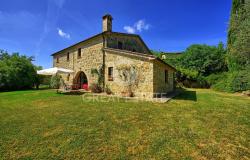The legend of Niobe, wife of Amphion King of Thebes, is re-brought to life in Hall 42 bearing the same name at the Uffizi Gallery in Florence, following two years of restoration.
The Hall will welcome visitors in its original splendour and furnishing dating back to the late 18th century and created under the patronage of the then director Luigi Lanzi.
The lavish furnishing of the hall traces the history of Niobe who in vain seeks to protect one of her seven daughters in a desperate embrace.
The gods show their implacable wrath to humans guilty of hybris, a combination of arrogance and haughtiness and Niobe, who proudly considered herself more fertile than Latona, saw Artemis and Apollo kill her 14 children one after the other.
The restoration works, worth more than 300,000 euro, were financed by Friends of Florence, a non-profit international foundation chaired by Countess Simonetta Brandolini d'Adda. Painting Ratto di Proserpina by Giuseppe Grifoni, which was originally in the hall, was restored and re-brought there from Serristori Palace.
It looked more like a rag than a painting, Brandolini d'Adda said. It had many holes and was heavily damaged. Now it has come back to life, thanks to the expertise and efforts of Murial Vervat and Antonio Casciani.
The Ratto, together with the monumental canvass by Giusto Suttermans which portrays the Florence Senate and pays homage to Ferdinand II de Medici, has been placed at the entrance wall of the hall which is located in Corridor number three at Uffizi. Other paintings on show include two by Rubens, portraying Henri IV of France during the Ivry battle and triumphantly entering Paris. Rubens works were restored after being damaged by the car-bomb attack in Georgofili Street in May 1993.
The new arrangement of Hall 42, originally known as Sala 42 della Niobe, has removed two objects that were not part of the hall s original furnishing. A place in the hall next to the Niobe statues was regained by a restored Roman sarcophagus dating back to between 165 and 185 A.D.
The lighting of the room was changed too. The spotlights now emit soft light which, together with the curtains filtering the external light, make the preciously decorated ceiling and the water-green walls - typical elements of the Neoclassical interior - stand out.
Over the past six years private U.S. donors have offered us more money to safeguard our artistic heritage than private Florence donors have offered us in half a century, Antonio Paolucci, superintendent of the Florence Museum Complex (Polo museale fiorentino) said.
This is a crude materialistic observation but it is true and it is not my fault if the truth is sometimes embarrassing, he added. The opening of the restored hall was attended by Florence mayor Leonardo Domenici, who recalled how Florence Municipality has invested 74 million euro in maintenance and restoration of the city s artistic heritage since 2000. Among those present was also U.S. Ambassador to Italy Ronald Spogli, who pointed out that the restoration had built a bridge linking the two coasts of the Atlantic.













